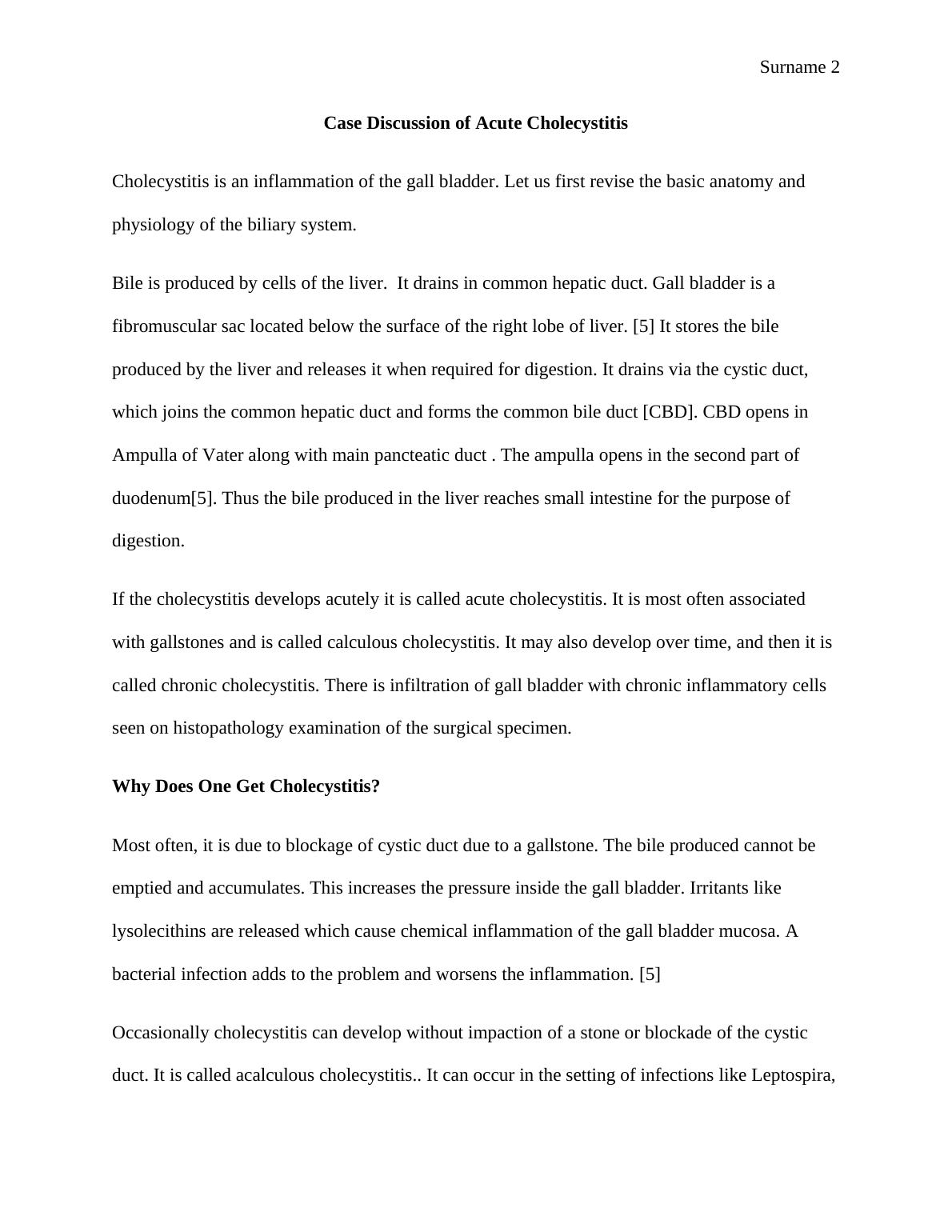Case Discussion of Acute Cholecystitis
9 Pages1936 Words178 Views
Added on 2020-02-03
Case Discussion of Acute Cholecystitis
Added on 2020-02-03
ShareRelated Documents
Surname 1Case Discussion of Acute CholecystitisStudent’s nameInstitutionCourseDate

Surname 2Case Discussion of Acute CholecystitisCholecystitis is an inflammation of the gall bladder. Let us first revise the basic anatomy and physiology of the biliary system.Bile is produced by cells of the liver. It drains in common hepatic duct. Gall bladder is a fibromuscular sac located below the surface of the right lobe of liver. [5] It stores the bile produced by the liver and releases it when required for digestion. It drains via the cystic duct, which joins the common hepatic duct and forms the common bile duct [CBD]. CBD opens in Ampulla of Vater along with main pancteatic duct . The ampulla opens in the second part of duodenum[5]. Thus the bile produced in the liver reaches small intestine for the purpose of digestion.If the cholecystitis develops acutely it is called acute cholecystitis. It is most often associated with gallstones and is called calculous cholecystitis. It may also develop over time, and then it is called chronic cholecystitis. There is infiltration of gall bladder with chronic inflammatory cells seen on histopathology examination of the surgical specimen.Why Does One Get Cholecystitis?Most often, it is due to blockage of cystic duct due to a gallstone. The bile produced cannot be emptied and accumulates. This increases the pressure inside the gall bladder. Irritants like lysolecithins are released which cause chemical inflammation of the gall bladder mucosa. A bacterial infection adds to the problem and worsens the inflammation. [5]Occasionally cholecystitis can develop without impaction of a stone or blockade of the cystic duct. It is called acalculous cholecystitis.. It can occur in the setting of infections like Leptospira,

Surname 3Salmonella, prolonged fasting, burns etc [6]. One should be watch out for it in patients admitted in critical care units. The signs and symptoms can be subtle and go unnoticed till the gall bladderperforates or develops gangrene. It probably occurs secondary to multiple factors including ischemia of the gall bladder, atherosclerosis and decreased tissue perfusion secondary to the critical illness from which the patient is suffering [7]However our case study patient is not a likely candidate to have acalculous cholecystitis.With this background knowledge, let us study the case of Mr. Kasim [name changed], a 49 year old man He presented to emergency department, with an illness of two days durationHis chief complaints were abdominal pain in the right upper quadrant, fever, vomiting and pain at the shoulder tipLet us see the positive findings in the clinical examination.He had fever, tachycardia, hypotension, dryness of mucosal membranes and pallorThe findings of his examination of abdomen, respiratory and cardiovascular system are not givenin the case summaryLet us start with the basics of signs and symptoms. Knowing these basics will be helpful in evaluation of any patientNormal average oral body temperature is 36.8 degree C [1]. When it is above 37.2 [in morning] and 37.7 [in evening], we call it fever. [1]

End of preview
Want to access all the pages? Upload your documents or become a member.
Related Documents
Diagnosis and Management of Cholecystisislg...
|6
|939
|204
Case Study about Digestion 2022lg...
|5
|907
|16
